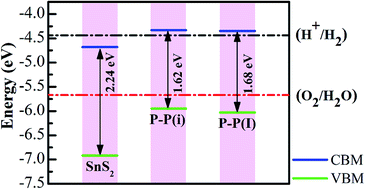Our official English website, www.x-mol.net, welcomes your
feedback! (Note: you will need to create a separate account there.)
Band gap engineering of SnS2 nanosheets by anion–anion codoping for visible-light photocatalysis
RSC Advances ( IF 3.9 ) Pub Date : 2018-01-17 00:00:00 , DOI: 10.1039/c7ra12058c Xiaoxia Zhu 1 , Xukai Luo 1 , Hongkuan Yuan 1 , Hong Chen 1 , Chunling Tian 1
RSC Advances ( IF 3.9 ) Pub Date : 2018-01-17 00:00:00 , DOI: 10.1039/c7ra12058c Xiaoxia Zhu 1 , Xukai Luo 1 , Hongkuan Yuan 1 , Hong Chen 1 , Chunling Tian 1
Affiliation

|
SnS2 nanosheets with three atom thickness have previously been synthesized and it has been shown that visible light absorption and hydrogen evolution through photocatalytic water splitting are restricted. In the present study, we have systematically investigated the electronic structures of anionic monodoped (N and P) and codoped (N–N, N–P, and P–P) SnS2 nanosheets for the design of efficient water redox photocatalysts by adopting first principles calculations with the hybrid HSE06 functional. The results show that the defect formation energies of both the anionic monodoped and all the codoped systems decrease monotonically with the decrease of the chemical potential of S. The P–P codoped SnS2 nanosheets are not only more favorable than other codoped systems under an S-poor condition, but they also reduce the band gap without introducing unoccupied impurity states above the Fermi level. Interestingly, although the P–P(ii) codoped system gives a band gap reduction, this system is only suitable for oxygen production and not for hydrogen evolution, which indicates that it may serve as a Z-scheme photocatalyst for water splitting. The P–P(i) codoped system may be a potential candidate for photocatalytic water splitting to generate hydrogen because of the appropriate band gap and band edge positions, which overcome the disadvantage that the pure SnS2 nanosheet is not beneficial for hydrogen production. More importantly, the result of optical absorption spectral analysis shows that the P–P(i) codoped SnS2 nanosheet absorbs a longer wavelength of the visible light spectrum as compared to the pristine SnS2 nanosheet. The P–P(I) codoped system with a lower doping concentration also has an absorption shift towards the visible light region.
中文翻译:

阴离子-阴离子共掺杂 SnS2 纳米片的带隙工程用于可见光光催化
先前已合成了具有三个原子厚度的SnS 2纳米片,并且已表明可见光吸收和通过光催化水分解产生的氢受到限制。在本研究中,我们系统地研究了阴离子单掺杂(N和P)和共掺杂(N-N、N-P和P-P)SnS 2纳米片的电子结构,用于设计高效的水氧化还原光催化剂。混合 HSE06 泛函的原理计算。结果表明,阴离子单掺杂和所有共掺杂体系的缺陷形成能均随着S化学势的降低而单调降低。P-P共掺杂SnS 2纳米片不仅比其他共掺杂体系在S的作用下更有利。 -条件较差,但它们也可以减小带隙,而不会引入费米能级以上的未占据杂质态。有趣的是,虽然P-P(ii)共掺杂系统可以减小带隙,但该系统仅适用于产氧,不适用于析氢,这表明它可以作为水分解的Z型光催化剂。 P-P(i)共掺杂体系由于具有适当的带隙和能带边缘位置,可能成为光催化水分解制氢的潜在候选者,克服了纯SnS 2纳米片不利于制氢的缺点。 更重要的是,光学吸收光谱分析的结果表明,与原始SnS 2纳米片相比,P-P(i)共掺杂SnS 2纳米片吸收更长波长的可见光谱。具有较低掺杂浓度的P-P(I)共掺杂系统也具有向可见光区域的吸收偏移。
更新日期:2018-01-17
中文翻译:

阴离子-阴离子共掺杂 SnS2 纳米片的带隙工程用于可见光光催化
先前已合成了具有三个原子厚度的SnS 2纳米片,并且已表明可见光吸收和通过光催化水分解产生的氢受到限制。在本研究中,我们系统地研究了阴离子单掺杂(N和P)和共掺杂(N-N、N-P和P-P)SnS 2纳米片的电子结构,用于设计高效的水氧化还原光催化剂。混合 HSE06 泛函的原理计算。结果表明,阴离子单掺杂和所有共掺杂体系的缺陷形成能均随着S化学势的降低而单调降低。P-P共掺杂SnS 2纳米片不仅比其他共掺杂体系在S的作用下更有利。 -条件较差,但它们也可以减小带隙,而不会引入费米能级以上的未占据杂质态。有趣的是,虽然P-P(ii)共掺杂系统可以减小带隙,但该系统仅适用于产氧,不适用于析氢,这表明它可以作为水分解的Z型光催化剂。 P-P(i)共掺杂体系由于具有适当的带隙和能带边缘位置,可能成为光催化水分解制氢的潜在候选者,克服了纯SnS 2纳米片不利于制氢的缺点。 更重要的是,光学吸收光谱分析的结果表明,与原始SnS 2纳米片相比,P-P(i)共掺杂SnS 2纳米片吸收更长波长的可见光谱。具有较低掺杂浓度的P-P(I)共掺杂系统也具有向可见光区域的吸收偏移。











































 京公网安备 11010802027423号
京公网安备 11010802027423号